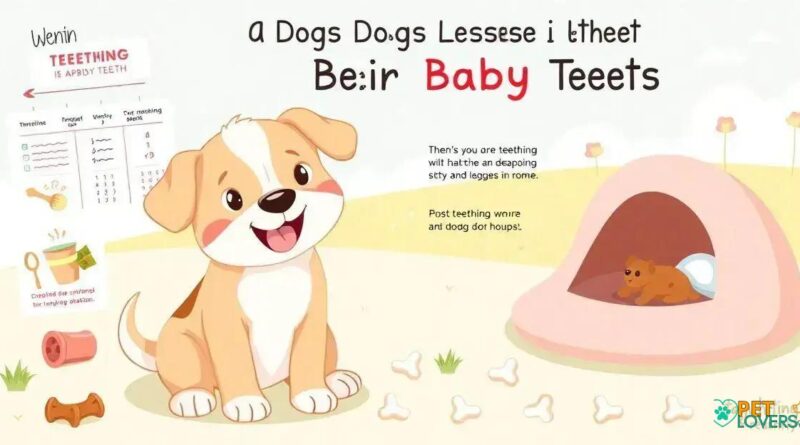When Do Dogs Lose Their Baby Teeth? Surprising Facts Revealed!
Teething is a natural phase in a puppy’s life where they transition from baby teeth to adult teeth, typically occurring between 3 to 6 months of age. During this time, it’s important to provide appropriate chew toys and maintain a balanced diet to ease discomfort. If your puppy shows signs of excessive pain or distress, consulting a veterinarian is advisable to ensure their health and comfort during this developmental stage.
Are you wondering when your dog will lose those tiny baby teeth? You’re not alone! The process of teething can be a mysterious and fascinating experience for dog owners.
As your furry friend grows and develops, their baby teeth gradually fall out, making way for the adult teeth.
In this article, we’ll explore the teething timeline, the role of diet in dog teething, and some surprising facts about the process.
So, buckle up and get ready to learn more about your dog’s dental development!
Teething Timeline: When Do Puppies Lose Their Baby Teeth?
As a responsible dog owner, you’re likely wondering when your furry friend will lose those tiny baby teeth. The teething timeline varies from puppy to puppy, but generally, it begins around 3-4 months old and continues until they’re about 6-7 months old. During this time, you may notice your puppy’s baby teeth start to loosen and eventually fall out, making way for their adult teeth. Keep in mind that every dog is different, and the teething process can be influenced by factors such as breed, diet, and overall health.
A well-balanced diet plays a crucial role in your dog’s teething process. A diet rich in essential nutrients, vitamins, and minerals can help support healthy tooth development and reduce the risk of dental problems. Feeding your dog a high-quality puppy food that’s formulated for their age and size can help ensure they receive the necessary nutrients for healthy teething. Additionally, providing your dog with teething toys and chews made from natural materials like rubber or fabric can help soothe their gums and reduce discomfort.
Teething can be a challenging time for puppies, and as a responsible dog owner, it’s essential to be aware of the signs and symptoms your dog may exhibit. Common signs of teething in dogs include excessive drooling, panting, and chewing. You may also notice your dog’s gums becoming swollen and red, or their teeth becoming loose. If you’re concerned about your dog’s teething process or notice any signs of discomfort, it’s always best to consult with your veterinarian for professional advice.
As your dog navigates the teething process, it’s common for their gums to become sore and irritated. Fortunately, there are several home remedies you can try to help soothe your dog’s gums and reduce discomfort. One effective remedy is to rub your dog’s gums with a clean, damp cloth or a teething gel. You can also try providing your dog with frozen teething toys or chews to help numb the pain and reduce swelling. Always consult with your veterinarian before trying any new remedies to ensure their safety and effectiveness.
Watching your dog grow and develop is a truly special experience, and the teething process is an essential part of their journey. By being aware of the teething timeline, the role of diet, and the signs and symptoms of teething, you can better support your dog’s overall health and well-being. Remember to always consult with your veterinarian if you have any concerns about your dog’s teething process or overall health.
The Role of Diet in Dog Teething
The teething timeline for puppies typically begins around 3-4 months old and can last up to 6-7 months. During this period, puppies will lose their baby teeth and replace them with adult teeth. The exact timeline may vary depending on breed, diet, and overall health. As your puppy grows and develops, it’s essential to monitor their teething process and provide them with proper care to ensure healthy tooth development.
A well-balanced diet plays a crucial role in your dog’s teething process. A diet rich in essential nutrients, vitamins, and minerals can help support healthy tooth development and reduce the risk of dental problems. Feeding your dog a high-quality puppy food that’s formulated for their age and size can help ensure they receive the necessary nutrients for healthy teething.
Teething can be a challenging time for puppies, and it’s essential to be aware of the signs and symptoms they may exhibit. Common signs of teething in dogs include excessive drooling, panting, and chewing. You may also notice your dog’s gums becoming swollen and red, or their teeth becoming loose. If you’re concerned about your dog’s teething process or notice any signs of discomfort, it’s always best to consult with your veterinarian for professional advice.
As your dog navigates the teething process, it’s common for their gums to become sore and irritated. Fortunately, there are several home remedies you can try to help soothe your dog’s gums and reduce discomfort. One effective remedy is to rub your dog’s gums with a clean, damp cloth or a teething gel. You can also try providing your dog with frozen teething toys or chews to help numb the pain and reduce swelling.
Watching your dog grow and develop is a truly special experience, and the teething process is an essential part of their journey. By being aware of the teething timeline, the role of diet, and the signs and symptoms of teething, you can better support your dog’s overall health and well-being. Remember to always consult with your veterinarian if you have any concerns about your dog’s teething process or overall health.
Signs of Teething in Dogs: What to Expect
During the teething process, puppies may exhibit a range of signs and symptoms that can be concerning for pet owners. Common signs of teething in dogs include excessive drooling, panting, and chewing.
You may also notice your dog’s gums becoming swollen and red, or their teeth becoming loose. Some puppies may also exhibit irritability, whining, or restlessness due to the discomfort caused by teething.
It’s essential to monitor your puppy’s behavior and consult with your veterinarian if you notice any of these signs or if your puppy is experiencing discomfort.
Home Remedies for Sore Gums in Dogs
If your puppy is experiencing sore gums due to teething, there are several home remedies you can try to help soothe their discomfort.
One effective remedy is to rub your puppy’s gums with a clean, damp cloth or a teething gel.
You can also try providing your puppy with frozen teething toys or chews to help numb the pain and reduce swelling.
Additionally, you can try giving your puppy a cold, wet washcloth to chew on, which can help reduce swelling and ease discomfort.
Always consult with your veterinarian before trying any new remedies to ensure their safety and effectiveness.
Conclusion: The Joy of Watching Your Dog Grow
As your puppy grows and matures, it’s a truly remarkable experience to witness their development. Watching your dog grow and change is a unique and special bond that brings joy and fulfillment to your life. By providing your puppy with proper care, nutrition, and attention, you’re not only helping them grow physically but also emotionally and mentally.
As your puppy becomes an adult dog, you’ll continue to cherish the memories and experiences you’ve shared together, and you’ll be proud of the strong, healthy, and happy dog you’ve raised.
Watching Your Dog Grow and Thrive
By understanding the teething timeline, the role of diet, and the signs and symptoms of teething, you can better support your dog’s overall health and well-being.
Remember to always consult with your veterinarian if you have any concerns about your dog’s teething process or overall health.
With proper care and attention, your puppy will grow into a happy, healthy, and well-adjusted adult dog.
So, cherish the journey and enjoy watching your dog grow and thrive.
FAQ – Frequently Asked Questions About Dog Teething
What are the signs of teething in dogs?
Common signs of teething in dogs include excessive drooling, panting, and chewing. You may also notice your dog’s gums becoming swollen and red, or their teeth becoming loose.
How can I soothe my dog’s sore gums during teething?
You can try rubbing your dog’s gums with a clean, damp cloth or a teething gel. You can also provide your dog with frozen teething toys or chews to help numb the pain and reduce swelling.
What role does diet play in dog teething?
A well-balanced diet plays a crucial role in your dog’s teething process. A diet rich in essential nutrients, vitamins, and minerals can help support healthy tooth development and reduce the risk of dental problems.
Can I use home remedies to help my dog during teething?
Yes, there are several home remedies you can try to help soothe your dog’s discomfort during teething. Always consult with your veterinarian before trying any new remedies to ensure their safety and effectiveness.
How can I support my dog’s overall health during teething?
By understanding the teething timeline, the role of diet, and the signs and symptoms of teething, you can better support your dog’s overall health and well-being. Remember to always consult with your veterinarian if you have any concerns about your dog’s teething process or overall health.
What are the long-term benefits of proper teething care?
Proper teething care can help ensure your dog’s teeth and gums develop properly, reducing the risk of dental problems and promoting overall health and well-being.





